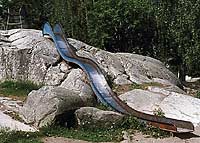|

|

|
NEWS SEARCH
|
|
|
|

|
|
|
A
new generation of playgrounds, this one in Scandinavia, illustrates
the fresh thought being given to designing for children
|
"Designing Modern
Childhoods" conference at UC Berkeley to explore architecture, design,
from kids' perspectives
29 April 2002
By
Kathleen Maclay, Media Relations
Berkeley
- If children could design their own play structures, schools, summer
camps and even fast food, what would they come up with?
 |

Another
take on a child's playground, this one taking advantage of the existing
landscape
|
At
a first-of-its-kind international conference - "Designing Modern Childhoods:
Landscapes, Buildings and Material Culture" - to be held May 2-3 at
the University of California, Berkeley, an interdisciplinary group of
architects, landscape architects, urban planners, historians, sociologists,
environmental psychologists, folklorists, and geographers will explore
those questions and more.
Marta Gutman, architect and historian at UC Berkeley, and Ning de
Coninck-Smith, cultural historian from Southern Denmark University,
Odense, organized the free event to promote conversation between those
often involved in the design, construction, use and analysis of the
places and objects created for children.
"This exciting conference will bring adult perspectives on childhoods
together with the views of children themselves," said Barrie Thorne,
professor of sociology and women's studies and director of the Berkeley
Center for Working Families.
"It is essential that we bring together scholars from various fields
to see just how much we know about children, past and present. By situating
children fully in their material environments, architects, designers,
and scholars will learn and share new research and reinforce our commitment
to children's studies," said Paula Fass, a UC Berkeley professor of
history. Fass and Thorne are among the conference's 65 scheduled speakers.
The following
three keynote addresses will address issues facing parents, children,
educators and designers:
- "The Wondrous
Child: American Ad Images and the Origins of Commercialized Childhood,"
by Gary Cross historian from Pennsylvania State University, 1:30 p.m.
Thursday.
- Cutting-edge designs
of schools in France, by Anne-Marie Châtelet, architect and historian,
9 a.m. Friday.
- The design of
places, according to different ideas about children and child rearing,
by Roger Hart, environmental psychologist from the City University
of New York, 2:30 p.m. Friday.
Other topics to be addressed include:
- How "foodscapes," such as theme restaurants; the production of new
shapes and colors of food to make it "entertaining;" and licensing tie-ins
between food and cartoons or films to promote "children's food" promote
the child as a consumer
- How children in Los Angeles feel about freeways
- How innovative public libraries are redesigning to attract deliberately
long-ignored teen patrons
- How a Los Angeles County court sought input from youth in the design
of a new facility to handle complex and sensitive child dependency cases
- Designing summer camps for children with disabilities
- The history of kindergarten architecture
- What may help or hinder development of new prototypes for the next
generation of Head Start buildings
- What English youth between the ages of 5 and 18 had to say in 2001
about their ideal school environments
- The design history of the Lego brick
- The differences between what happens at urban play structures at popular
fast food restaurants that generally hide children from the gaze of
parents, compared to the constant surveillance of children at suburban
playgrounds and how the suburban playground objectifies mothers.
A photo exhibit, "Making Spaces for Small and Young Children to Play,"
will be on display during the meeting at the International House auditorium.
Exhibit curator Susan Solomon looked at today's public parks to see
which projects succeed and survive. Many landscape architects and designers
shy away from park projects because they feel restricted by the specter
of product liability and personal injury law suits, she said.
"Viewers should think about how playgrounds have become specific destinations
and how they have begun to exist in non-traditional forms, occupying
unusual sites. They should also consider how the playground has become
a tool for change in an urban context," Solomon said.
As part of the conference, she also is organizing a self-guided tour
of innovative playgrounds in the San Francisco Bay Area, known for providing
inventive places for children to play.
On the itinerary is the Adventure Playground in Berkeley, one of the
last remaining examples in the United States of a concept to give children
the illusion of danger while actually relying on strong safety elements,
Solomon said. The experiment proved popular in Europe but failed in
the United States, she said. Other parks on the list are in Berkeley,
Oakland, San Jose and San Francisco.
The conference is supported by grants from the Center for Working
Families, which is sponsored by the Alfred P. Sloan Foundation; Center
for Child and Youth Policy; Doreen B. Townsend Center for the Humanities;
the History Department; and College of Environmental Design - all at
the University of California, Berkeley. Also supporting the conference
is the Institute of Literature, Media, and Cultural Studies at the Southern
Denmark University, Odense, and the Kompan Corporation.
The conference is open to the public, but registration is required.
###
|

|